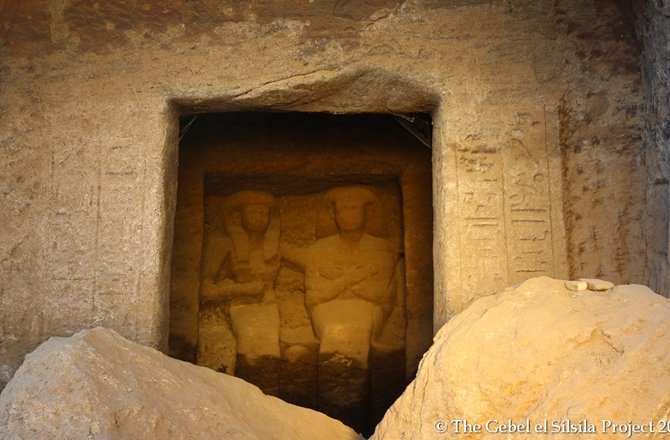
The 3,400-year-old statues were found at Gebel el Sisila, a site north of Aswan known for its stone quarries on both sides of the Nile. Blocks used in building almost all of ancient Egypt's great temples were cut from there.
The statues were carved within two of the 32 shrines erected by the officials who were in charge of quarrying the stone.
The two shrines are located about half a mile south of Gebel el Sisila's most famous monument, the rock-cut temple known as the Speos of Horemheb. In antiquity they suffered some fracturing due to earthquakes, and erosion due to their submersion by the Nile during the flood season.
"The shrines were described as almost completely destroyed," el-Damaty said.
On the contrary, a Swedish mission from Lund University, led by Maria Nilsson, found the chapels, known as shrine 30 and shrine 31, preserved in their entirety.
Nilsson worked in cooperation with the inspectorate of Kom Ombo under General Director Abd el Menum, and the inspectorate of Aswan under General Director Nasr Salama.
Shrine 30 featured intact architectural elements, such as the doorway with its lintel, door jamb, threshold, interior walls and ceiling. At the back of the shrine, within a niche, the archaeologists found two life-size statues.
"They show a male and a female seated on a couch, positioned slightly towards each other in a private embrace," Nilsson said.
The male figure, and owner of the shrine, is portrayed with enlarged and protruding ears, large nose and lips, and sunken eyes. His arms are crossed over his chest, in the so-called Osirian position, and he wears a shoulder-length hair wig.
Portrayed with equally pronounced facial features, the female statue embraces the male, one arm placed on the male's shoulder, and the other hand in front of her chest.
"We have no clues so far about the identity of this couple. Unfortunately there is no information preserved within the hieroglyphic text," Nilsson told Discovery News.
Nilsson's team also found that the other monument, known as Shrine 31, had retained all its original architectural details, including its threshold, floor, door jambs and internally dressed walls.
"The shrine in fact is the best preserved of all 32 cenotaphs at Gebel el Silsila," associate director John Ward said.
Seated and placed within a niche, the archaeologists found four well-preserved statues, two male and two females.
"The main male figure, depicted with his arms in the Osirian position, is the owner of the shrine, Neferkhewe," Nilsson and Ward said.
Active during the reign of Thutmosis III, Neferkhewe is described within the shrine as "the overseer of the foreign lands" and "chief of the medjay (a region in northern Sudan)."
He wears a shoulder-length wig and is also portrayed with enlarged ears, sunken eyes large nose and lips, all set within a rounded face.
Neferkhewe's wife, Ruiuresti, sits to the far left. Boasting facial features similar to those of her husband, she is portrayed with her arm around his Neferkhewe, holding an object in her other hand.
The two remaining statues, seated on the right side, likely portray the couple's children, a daughter and a son.
According to the archaeologists these two carvings were remodeled during antiquity due to severe damage caused by fracturing to the sandstone.
"The statues are very finely carved, but were damaged and rubbed down by the tides of the water and years of being packed under silt," Nilsson said.
Preliminary results of the translations of the hieroglyphic texts and titles indicate that the names of the two children are not previously known.
"The identity of the son is not that of the famous son of Neferkhewe and Ruiuresti, Menkheperresonb, who is known from other sources," Nilsson and Ward said
The archaeologists also discovered relief scenes on both the northern and the southern walls of Shrine 31.
There, Neferkhewe and Ruiuresti remain the main subjects. They are seated upon thrones and are portrayed receiving offerings from their children.
General Manager of Aswan Archaeological Area, Nasr Salama said Nilsson's team will continue the excavation work in the attempt to discover more inside the 32 chapels of Gebel el Sisila.



Reader Comments
to our Newsletter